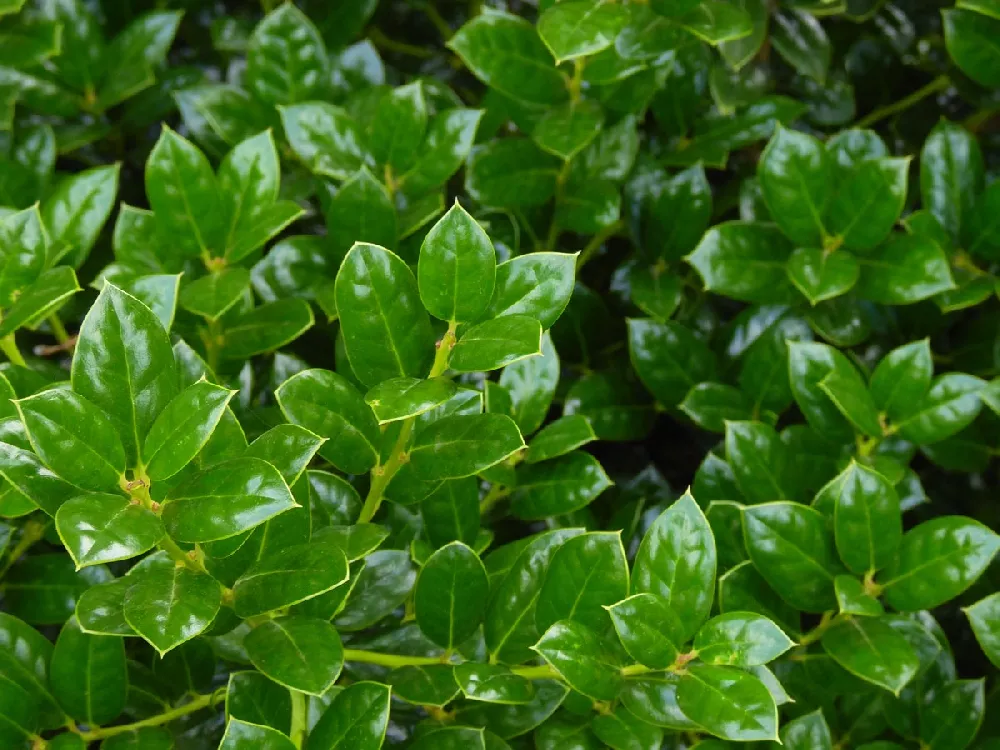- Home >
- Holly Trees >
- Dwarf Burford Holly
Dwarf Burford Holly for Sale
- Ships in 1-2 days
- 1-Year Warranty Eligible
- Pots or accessories are not included unless specified in the product options.
Shipping Details:
Products shipped through FastGrowingTrees.com. Once your order is shipped, you’ll receive an email with a tracking number and estimated delivery date. Most orders will ship immediately.
The dwarf Burford holly is a small and versatile shrub that offers more visual appeal than most evergreen species. Known botanically as Ilex cornuta 'Burfordii Nana,' this cultivated dwarf plant has broad, evergreen leaves that provide a lustrous shine all year. As is the case for most hollies, this plant also holds a beautiful set of red berries later in the year. But what's different about this holly is that it does not require cross-pollination to produce those berries as most do. The dwarf Burford holly also has a small size and a dense growth habit that lends itself nicely to pruning and shaping.
- The dwarf Burford holly has glossy evergreen leaves.
- Its compact shape is suitable for shaping.
- Its beautiful red berries require no cross-pollination.
Plant Care
Sunlight

The dwarf Burford holly grows in both full sunlight and partial shade.
Watering
Water once per week until established. After establishment, water during hot weather and dry spells.
Fertilizing

Use a holly-tone fertilizer once in spring and again in fall.
Planting and Care
Planting instructions
The dwarf Burford holly should receive full or partial sunlight and grow where the soil is slightly acidic. Beyond that, the dwarf Burford holly is not difficult to please. It can adapt to several soil types, survive drought, and withstand most heat waves. Once you find a suitable growing location, start the planting process by digging a hole that is as deep as the plant’s root ball and at least twice as wide. Backfill the hole with nutrient-rich soil, and cover the area with mulch.
Watering and nutrients
A mature dwarf Burford holly will have low water needs and may require supplemental watering only during times of extreme heat or drought. Until your plant reaches that level of maturity, you should support it by providing water about once per week or often enough to maintain consistent soil moisture. You should fertilize your dwarf Burford holly twice per year with a balanced fertilizer that helps keep the soil pH low. Fertilize once in the early spring, just before the new growth arrives, and once in fall, after active growth has ceased.
Pollination
One of the more intriguing facts about the dwarf Burford holly is that this plant is self-pollinating. Self-pollination is rare among holly plants, meaning that most species require cross-pollination to produce the ornamental fruits for which they are so well known. With the dwarf Burford holly, you can plant a single shrub and expect it to produce berries without the need for a pollination companion plant. As is the case for other hollies, the dwarf Burford holly relies on flies, bees, and other insects to conduct pollination.
Pruning
The correct time to prune a dwarf Burford holly is during the late winter or the early spring when the plant is still in its dormant phase. Typically, these shrubs respond quite well to pruning and shaping. You can use your pruning cuts to selectively remove any part of the plant that is dead, damaged, or diseased. You also have the option to shear the outer foliage of this plant and trim it into a specific shape of your choosing.
Pests, diseases, and animals
One convenient aspect of growing the dwarf Burford holly is that this cultivar is somewhat resistant to deer browsing compared to other hollies — and other plants in general. However, that does not mean that this plant is pest- and disease-free. Dwarf Burford hollies can encounter infestations of scale and other common insects. They can also contract infections that lead to leaf spots and canker. Root rot and nematodes are two other issues that can occasionally arise in this plant.
Achieving maximum results
One downside to growing the dwarf Burford holly is that it is much less cold-hardy than other popular holly varieties. Typically, this plant can only survive in hardiness zones 7 through 9. Other common hollies can survive in zones 5 and colder. You should also take advantage of how well this plant responds to shaping. For example, some gardeners shear their dwarf Burford hollies into formal shrubs, while others remove lower limbs to create a small tree-like appearance.
FAQs
What is the parent species of the dwarf Burford holly?
What is the correct spacing for a dwarf Burford holly?
The dwarf Burford holly can be 8 to 10 feet tall and wide at maximum but is often much smaller than that. As such, you don't need to leave too much space between these plants. If you wish to create a dwarf Burford holly hedge, you should space your plants about 3 to 4 feet from each other. If you wish to grow your dwarf Burford holly as an individual specimen, you should provide 6 feet or more of space.
Are the berries of a dwarf Burford holly poisonous?
While the red berries of dwarf Burford holly, and other hollies, are incredibly attractive, you should resist any urge you may have to eat them. Holly berries are poisonous to humans, which is why you should use them as nothing more than decoration in your home or garden. Likewise, you should be mindful of children who go near your dwarf Burford holly to ensure they never consume this plant's fruits.
Compare Similar Products
You can't add more Product Name - Product size to the cart.
OK










